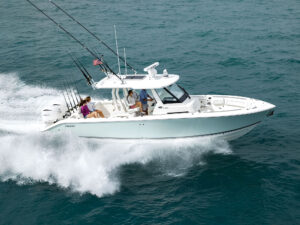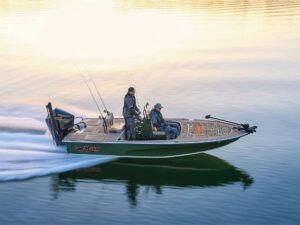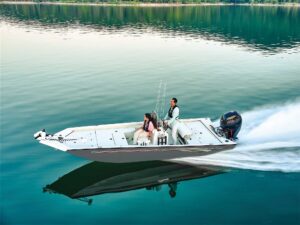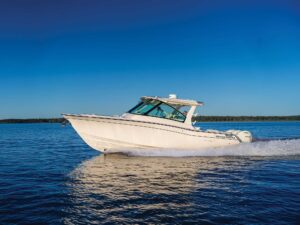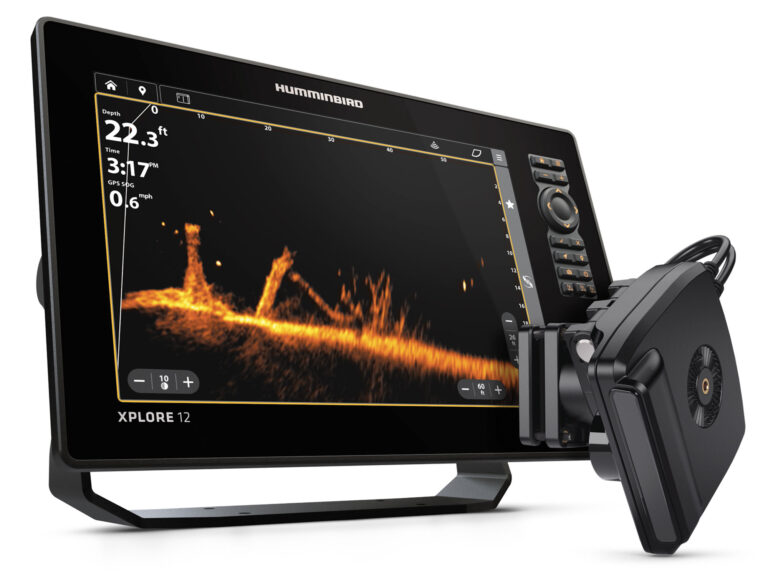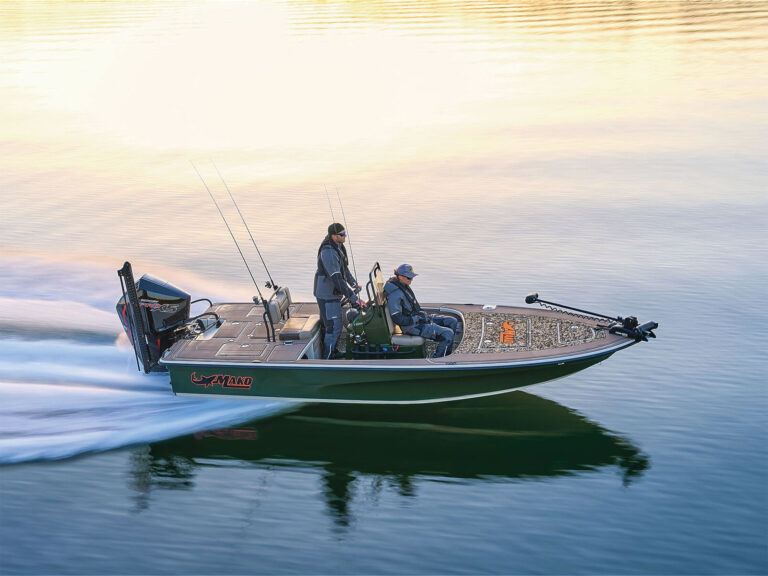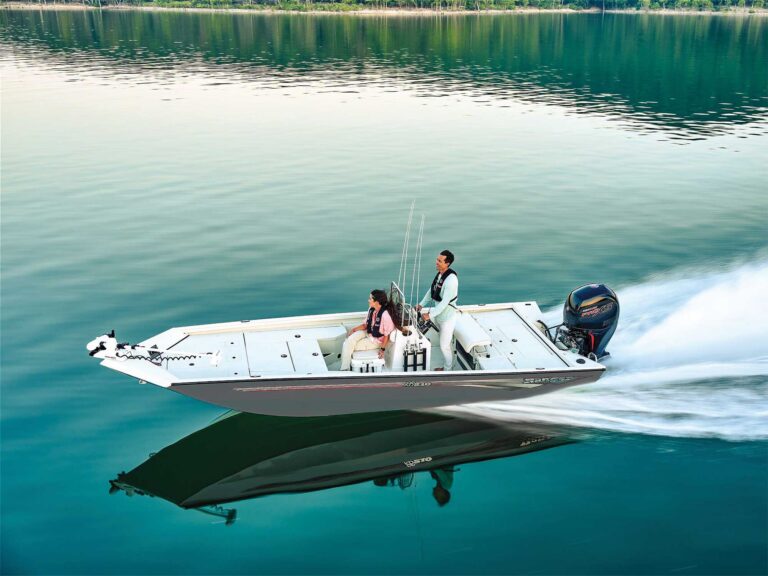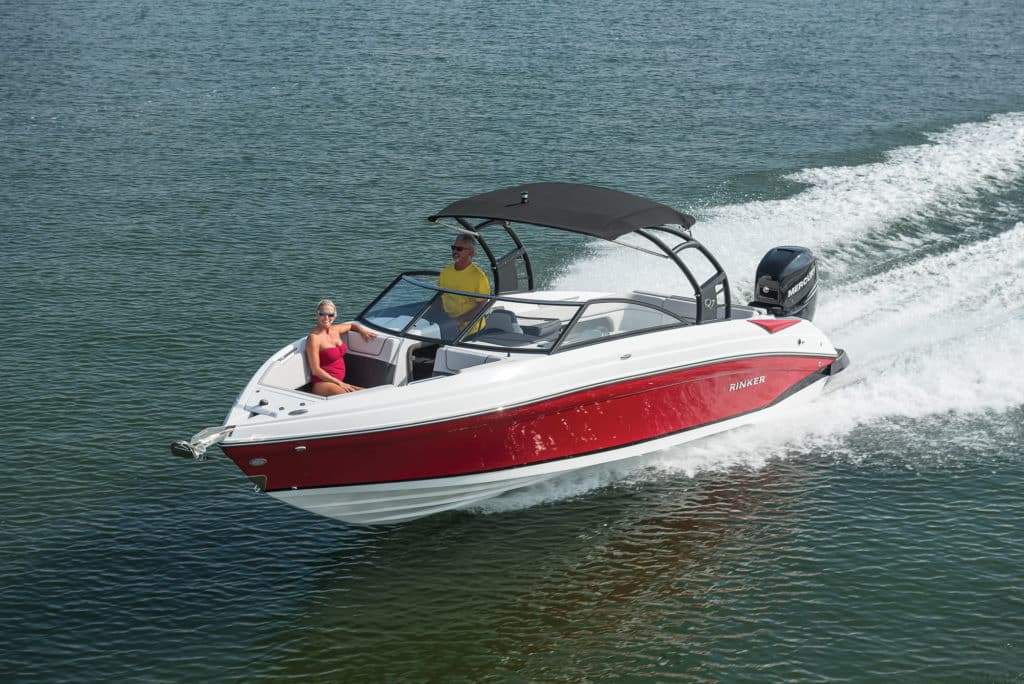
With its agile hull, clean modern lines, and open, inviting floor plan, Rinker‘s Q7 OB will likely be a hit not just underway but also at the sandbar. Still, that darn blender will probably overshadow all at first glance. Say what? The blender, a magnificent stainless-steel Waring, pivots out of its hiding space within the cockpit refreshment center’s countertop, already solidly mounted to the hatch that conceals it, permanently wired and ready to mix up the boat drinks. That it’s not an option on the Q7 but rather a standard feature speaks volumes about the Rinker brand and its designers. Yes, they’re not afraid of a gimmick to catch your attention, but they also truly understand how the target audience uses its boats. Probably because they use them a lot themselves.
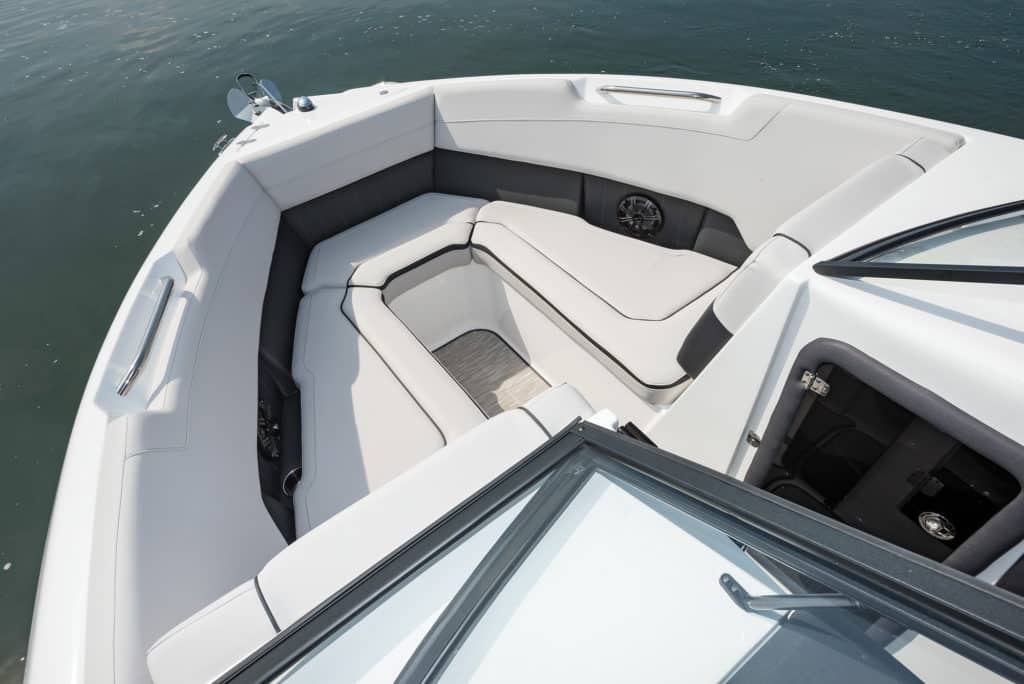
That practical knowledge and attention to detail is revealed throughout. Check out the interior. Forward, the bow cockpit invites a crew to socialize, or just a pair to stretch out against the gently sloping seat backs, but it’s the depth that immediately caught my attention. Even at its lowest point, there’s still well over 3 feet of interior wall enveloping passengers. That depth sinks bow occupants below the captain’s sightline to maintain a safer view. It also offers security for crew (and peace of mind for parents), especially in the open, rougher waters this boat can readily call home.
Step through the walk-through windshield into the main cockpit and the same secure feeling continues. Captain and mate get twin bucket seats, each with enveloping support and a flip-up bolster. Aft, a 5-foot-2-inch-by-4-foot L-shaped bench awaits to starboard; to port, a 4-foot-10-inch couch completes the social accommodations. Like the bow seating, each features a streamlined profile, with supportive padding, minimalist accent striping, and a carved-out inwale for storage and the requisite cup holders. Stainless-steel grab handles are located above all seat backs so that no passenger is left wanting for a handhold. Behind the helm, the aforementioned refreshment center includes a sink, stainless-steel faucet, and plenty of solid-surface counter space. Add the side-mounted pedestal table and the optional electric fridge featured on our test boat, and the drinks and hors d’oeuvres are ready to take center stage.
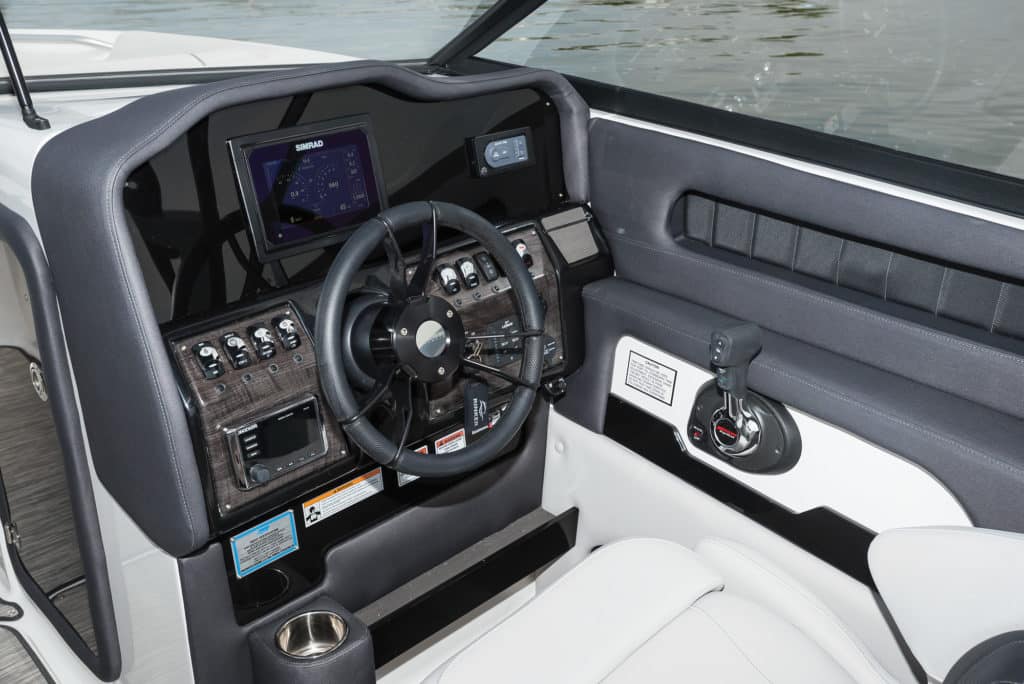
At anchor or nosed into the sandbar, that cockpit crowd will likely spill onto the aft platform. Here, Rinker designers mixed form and function with a unique take on an outboard’s seating and swim platform. Recognizing that passengers would most likely trod over a cushioned rumble seat, they maintained the padded seat back but replaced the bottom with an extra-thick layer of EVA traction material, finished with a soft, brushed texture. With the padded backrest, it makes a suitable perch when coving or gearing up for watersports but also offers a smart way to navigate around the outboard motor when boarding or disembarking from the stern. Dual swim platforms flank the bracket-mounted motor and provide a spot for skiers and boarders to gear up or swimmers to come aboard via the three-step stainless-steel ladder.
Dig deeper into the boat and the not-so-obvious details continue to impress. Rather than the typical open cavern, the space below the helm is cleanly finished with composite lumber and features dedicated storage for both the 25-quart Igloo cooler and cockpit table, as well as a shelf and deep cylindrical trash can, which can be mounted to brackets on the door’s interior. The 3-foot-10-inch-by-2-foot-2-inch-by-2-foot-10-inch head compartment within the port console features a fiberglass liner, for both showroom appeal and low maintenance, a fiddled shelf and standard port-a-potty. The stowage space below most cockpit cushions is cleanly finished with low-maintenance roto-molded tubs. The clean dash swaps out multiple gauges for a single Simrad GO7 touchscreen display; lighted rocker switches with resettable breakers are arrayed below. To the left of the Gussi wheel resides the Kicker KMC10 head unit with Bluetooth capability; to the right is a padded vertical mount to secure your phone.
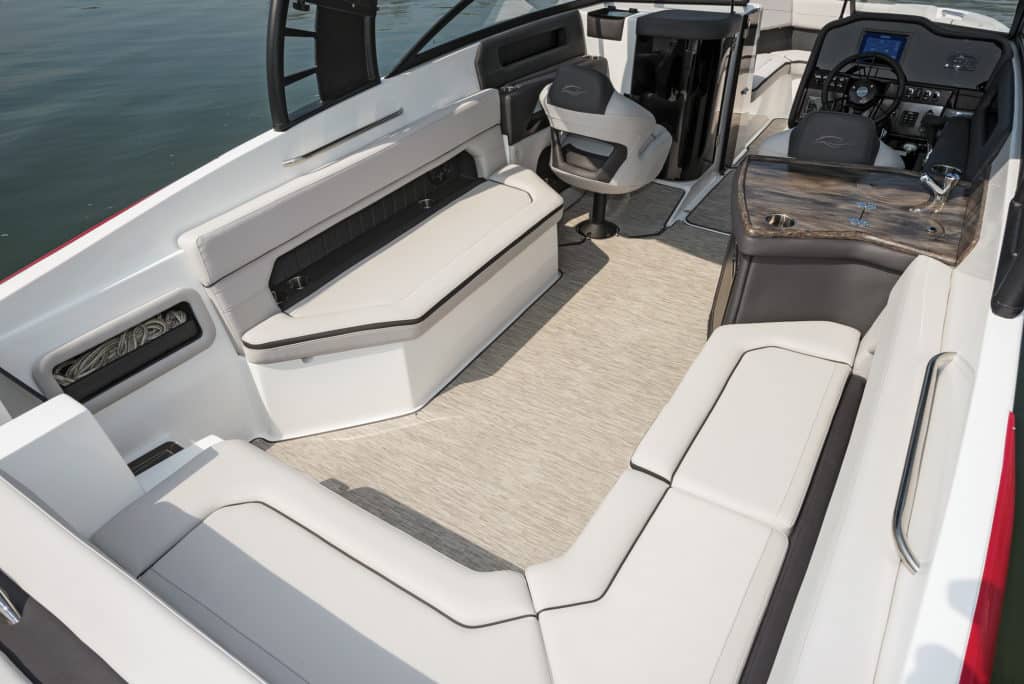
Our test boat was powered by a Mercury 300 Verado Pro, a powerful, quiet motor mounted off the transom on a custom bracket. It pushed the boat onto plane in 4.8 seconds with surprisingly minimal bow rise, and passed the 30 mph benchmark in 8.3 seconds. Top speed peaked at 53.9 mph. Economy? Most efficient cruise occurred at 22 mph, where the engine burned 8.5 gph. The hull handled our test day’s light chop with confidence and banked smoothly into turns, holding its line without hiccup.
Overall, it’s a design both similar to yet different than Sea Ray‘s nearly identically sized SDX 270 OB ($104,593 with Mercury 300 XL Verado Pro outboard). Both craft feature similar profiles and interior layouts. Sea Ray squares off the bow to enhance interior room in the forward cockpit, opts for doublewide helm and passenger seats with flip-over backrests, and sacrifices space in the main cockpit in favor of an aft sun pad and full-width swim platform. The head compartment includes a sink, pullout sprayer and opening portlight, but Rinker’s standards list includes the Simrad display, Bimini top, and the wet bar with sink and faucet. And yes, one very cool blender that will make you a hit at the sandbar.
High Points
- Standout details include a full-length padded armrest for your throttle elbow and forearm, molded-in inwale stowage for dock lines along the transom walk-through, gelcoat hull colors rather than stick-on graphics, and seemingly endless cup holders.
- Generous in-floor ski locker has room for a variety of tow toys; the hatch is finished off with a rubber seal to eliminate rattles underway.
- Optional watersports tower adds a stylish accent as well as a solid 7-foot attachment point for towing duties.
Low Points
- Portside head compartment door has a small vent but could benefit from a screened portlight, for both additional ventilation and welcome natural light.
- Pet peeve? Many boaters prefer to run with the walk-through windshield open for ventilation. We would prefer to see a strap or catch to keep it secured in place.
Price: $88,612 (with test power)
Available Power: Outboard
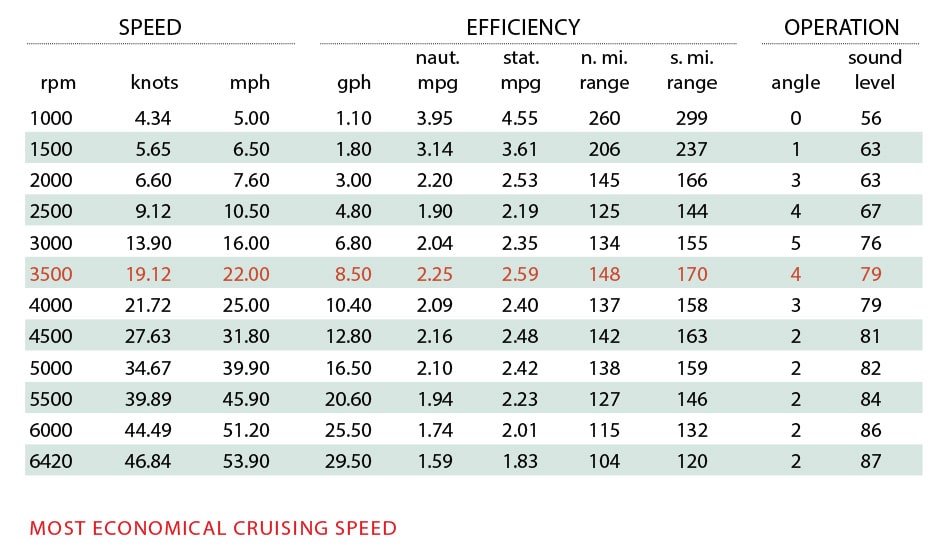
How We Tested
Engine: Mercury 300 Verado
Prop: Merc Enertia 14.2″ x 18″ 3-blade stainless steel
Gear Ratio: 1.85:1
Fuel Load: 50 gal.
Water on Board: 11 gal.
Crew Weight: 360 lb.
More Information
Rinker Boats – Syracuse, Indiana; 574-457-5731; rinkerboats.com

